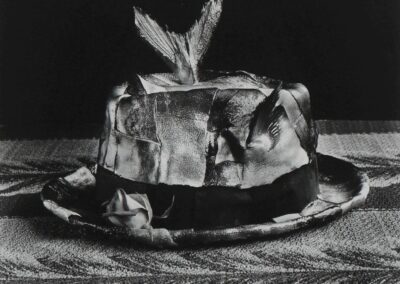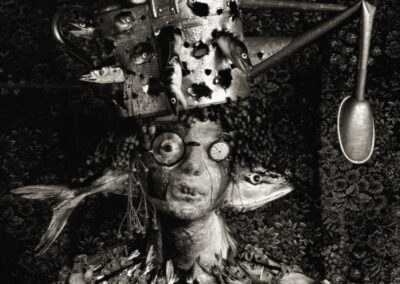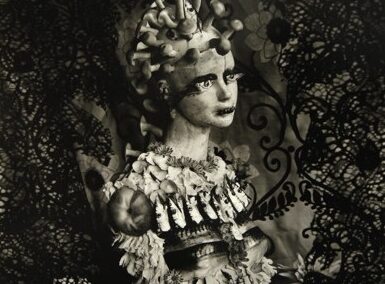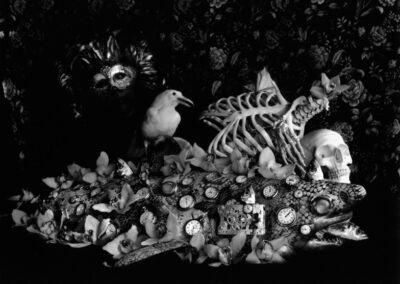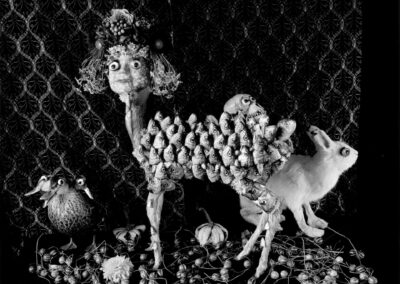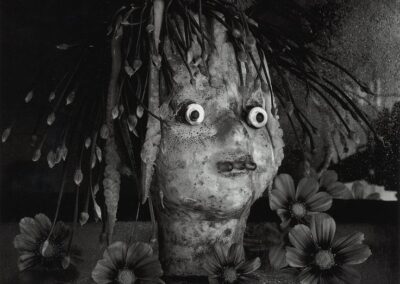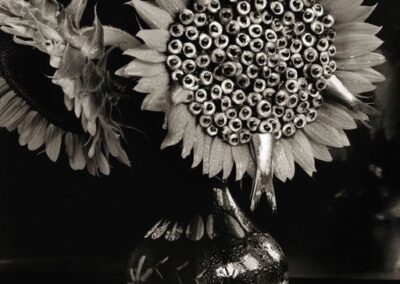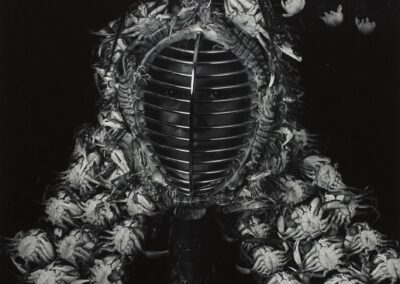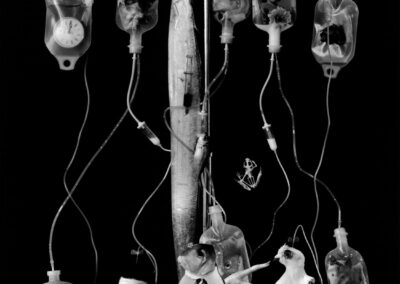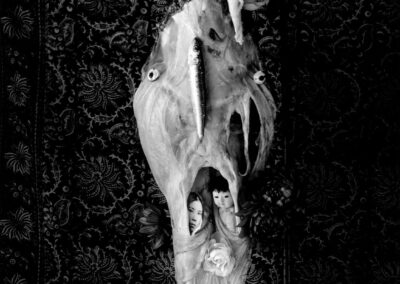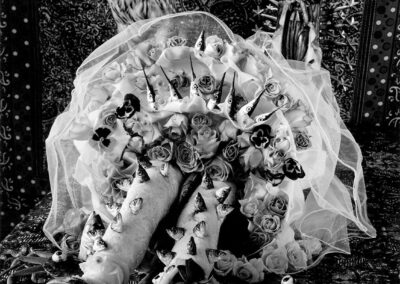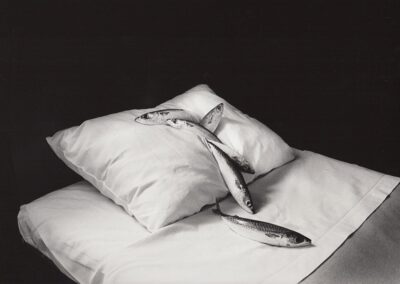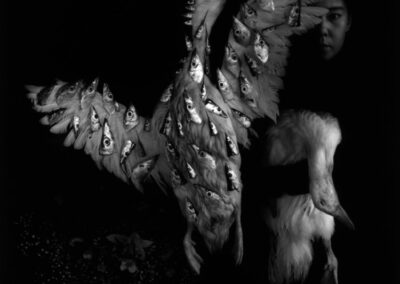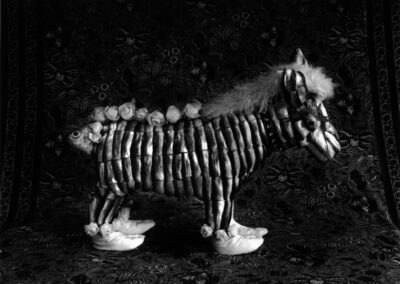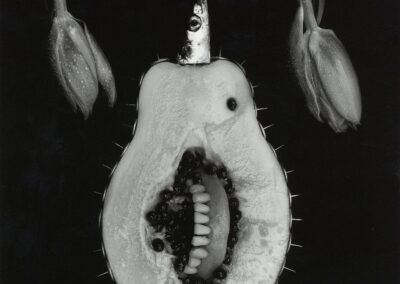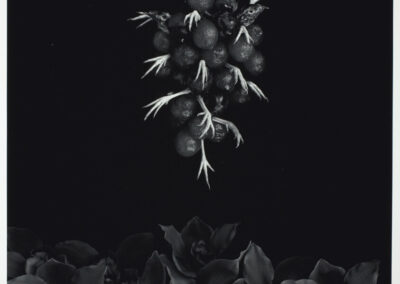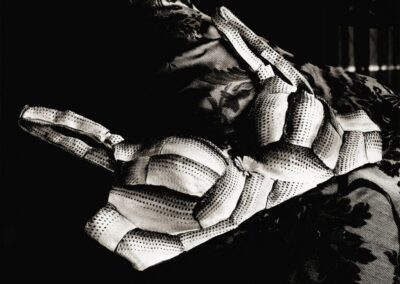Our next Artist You Need To Know is Michiko Kon | 今道子 | Kon Michiko.
She is a Japanese photographer who creates evocative monochromatic works that are comprised of a variety of objects that both are challenging and entrancing to the viewer. Michiko Kon’s images often explore themes such as death, sexuality, and beauty.
From here : “Michiko Kon creates assemblages with a minimalist background, and where biological elements such as sea creatures, plants and insects are in tension between an animate and inanimate reality. Her work is a parade of living creatures turned into inanimate objects, and inanimate objects turned into living creatures. Kon creates surreal still life scenographies, with seductively mundane objects, such as raw sea elements, vegetables and textile in order to get images of impossible pieces. Kon uses photography as her means of expression because it fixes this process of transformation.”
Michiko Kon was born in 1955 in Kanagawa Prefecture which is located in the Kantō region of Honshu (the largest and most populous island of Japan). She graduated from Sokei Art School where she focused primarily on painting and printmaking (1978) and would attend Tokyo Photographic College (1978 to 1980). Like many photographers of her generation of Japanese artists, she came to photography after a focus on other media and this is reflected in her aesthetic.
She mounted her first solo exhibition titled Still Life, at the Shinjuku Nikon Salon in 1985 in Tokyo, and seven years later in 1992 she had her first museum exhibition in the United States at the MIT List Visual Arts Center. Michiko produces limited edition Silver Gelatin prints as well as Platinum Palladium prints, which only add to the aesthetic flavour of her images.
Kon took a hiatus for several years to care for her aging mother. This lasted until 2014 but she has resumed the creation of her meticulously crafted photographs since 2014.
From John L. Tran at The Japan Times : “Her work combined a shocking use of animal parts with meticulous technique in a way that was both unsettling and visually seductive….[there is an] abominable beauty of Michiko Kon’s work….”
Kon’s images are often spoken about in tandem with the works of artists like Joel – Peter Witkin, and she did begin exhibiting during the same period as Damien Hirst began his ‘animal’ works, but her scenes have a subtlety, a consideration and especially a meditative quality, to quote many of the writings about her images, that both of those aforementioned artists lack (she has spoken of how she likes working with fish as it, for her, straddles a symbolism of life and death, of a physical and interpellated memento mori that is ‘banal’ and yet easily considered by a viewer). Her images also bring to mind the history of still life painting and photography in the western art historical canon, from seventeenth-century Dutch still lifes to surrealist works of the 1910s and 1920s.
Michiko Kon has been awarded the Kimura Ihei Prize (1991) and the Kanagawa Prefectural Art Exhibition Award (1994). She has also produced a number of books and collaborated on several others, including EAT (through the Art Works Committee, 1987 and revised version in 1991 with Shogakukan), Still Lifes (Aperture New York, 1997) and Michiko Kon : Still Lives (MIT List Visual Arts Center, Cambridge, 1992).
She was also included in the seminal exhibition The History of Japanese Photography organized by Anne Tucker at the Museum of Fine Arts, Houston, in 2003. Michiko Kon’s artworks can be found in numerous international collections, including the Art Institute of Chicago, the National Gallery of Australia, the National Gallery of Canada, the Tokyo Metropolitan Museum of Photography, Japan Itabashi Art Museum (Tokyo), Japan International Museum of Photography at George Eastman House (Rochester, NY), the Center for Creative Photography (University of Arizona, Tucson, AZ), The Art Museum (Princeton University, Princeton, NJ), Museum of Fine Arts (Houston, TX), MIT List Visual Arts Center (Cambridge, MA), The Art Gallery of New South Wales (Australia), the National Museum of Modern Art (Tokyo, Japan) and the Cleveland Museum of Art (Cleveland, Ohio).
The words of Katy Kline, writing for the exhibition (and aforementioned book) Michiko Kon: Photographs (MIT List Visual Arts Center, 1992):
“Kon’s photographs are strange, elegant, and slightly surreal still lifes. The photographic approach is deadpan documentary. This mischief resides in the arrangements themselves, which commingle dumb and inorganic objects of everyday life – hats, chairs, and undergarments – with equally familiar but organic materials ranging from flowers to vegetables to raw fish. The implication of inevitable decay makes these photographs into stark and powerful contemporary mementos mori.
The print quality of these dark and dramatic tableaux is exquisite and seductive, balancing luscious blacks with a variety of sheens and textures. The prints mimic the fastidious presentation techniques of food and fashion photography, which are carefully calculated to incite desire in the viewer. Yet the allure of these objects is undercut by the materials of their construction; imagine the cool clamminess of a fish-flesh fedora or the slippery flagellation of lingerie whose lace is composed of small herrings and safety pins.”
Despite the density of the iconography and symbolism in her photographs (both personal, or specific to the artist’s Japanese heritage, or referencing art historical tropes from the Western canon), Michiko Kon has asserted that “I want the viewer to enter into the image. My pictures cannot be misunderstood.”
A more complete listing of her exhibitions can be seen here and more artworks by Michiko Kon can be enjoyed here.

